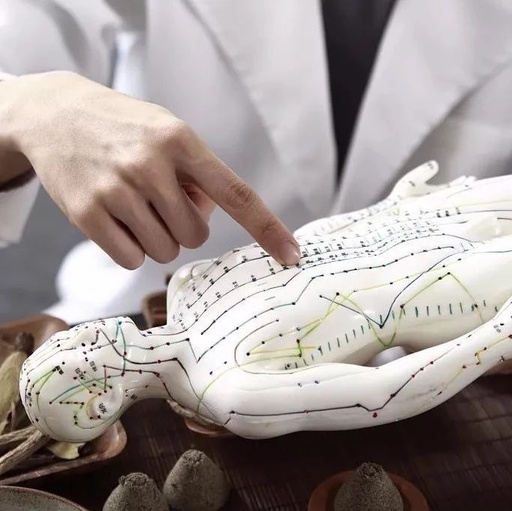Disease inquiry, health guidance, classic wellness, no need to seek help when ill
The meridians are the body’s natural pharmacy, and to control this divine treasure, it is sufficient to understand the operational principles of the 12 meridians, which is the essence of the entire meridian theory in Traditional Chinese Medicine (TCM).
There are over three hundred acupuncture points on the 12 meridians, and we do not need to memorize them all. Now, just follow me step by step, and it will be much easier.
1. First, familiarize yourself with the names of the 12 meridians:
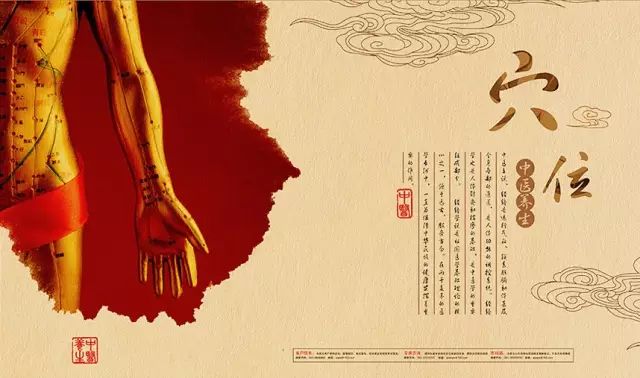
Shou Shaoyin Xin Jing (Hand Shaoyin Heart Meridian), Zu Shaoyin Shen Jing (Foot Shaoyin Kidney Meridian), Shou Jueyin Xinbao Jing (Hand Jueyin Pericardium Meridian), Zu Jueyin Gan Jing (Foot Jueyin Liver Meridian), Shou Taiyin Fei Jing (Hand Taiyin Lung Meridian), Zu Taiyin Pi Jing (Foot Taiyin Spleen Meridian), Shou Taiyang Xiao Chang Jing (Hand Taiyang Small Intestine Meridian), Zu Taiyang Pang Guang Jing (Foot Taiyang Bladder Meridian), Shou Shaoyang San Jiao Jing (Hand Shaoyang San Jiao Meridian), Zu Shaoyang Dan Jing (Foot Shaoyang Gallbladder Meridian), Shou Yangming Da Chang Jing (Hand Yangming Large Intestine Meridian), Zu Yangming Wei Jing (Foot Yangming Stomach Meridian)
2. Understand why they are named this way?
These 12 meridians are connected to the 12 organs of the human body, so these meridians are named after the connected organs. Among them, San Jiao refers to the entire chest and abdomen, and Xinbao is a protective area for the heart, serving as a barrier for the heart, while the rest are relatively easy to understand. Remembering the names of these 12 organs is very important; if you feel discomfort in any part of your body, check which meridian passes through that area, and you will find the corresponding one. From the arrangement of the 12 meridians, they are divided into two groups: one group is based on hands and feet, and the other is based on Yin and Yang.
The division by hands and feet indicates that there are 6 meridians on the hands and arms, and 6 meridians on the feet and legs.
The division by Yin and Yang indicates that there are 3 Yin meridians on the inner side of the arms and legs; there are also 3 Yang meridians on the outer side of the arms and legs.
Shaoyin, Jueyin, Taiyin, Taiyang, Shaoyang, and Yangming represent what? They represent the heaviness and lightness of Yin Qi, and the fullness and weakness of Yang Qi.
Shaoyin has the heaviest Yin Qi, so it is placed innermost on the inner side of the arms and legs.
Jueyin has lighter Yin Qi than Shaoyin but heavier than Taiyin, so it is placed in the middle.
Taiyin has the lightest Yin Qi, so it is placed on the outermost side.
Taiyang has the fullest Yang Qi, like the midday sun, so it is placed on the outermost side of the arms and legs.
Shaoyang has slightly weaker Yang Qi than Taiyang, like the sun at eight or nine in the morning, so it is placed in the middle of the outer side.
Yangming has weaker Yang Qi than Shaoyang, like the dawn light, so it is placed on the innermost side of the outer side.
Why did our ancestors subdivide Yin and Yang to such an extent? It is to remind you to pay attention to the balance of Yin and Yang when using the meridians. This balance of Yin and Yang includes the balance between meridians, the balance between the body and meridians, and the balance between meridians and nature. The balance between the body and meridians requires you to choose meridians based on the strength of your body. For example, if the body is weak, it is best to first choose Yang meridians for massage to replenish Zheng Qi; Yin meridians should be approached only after Zheng Qi is replenished; if the body is healthy, both Yin and Yang meridians can be massaged.
The balance of Yin and Yang between meridians and nature is related to the temperature of the four seasons. In summer, Yang Qi is most vigorous, so even those with weak bodies can unblock Yin meridians at this time. The theory of Yin and Yang balance can also be applied to the techniques used in massage; for example, the massage of Yin meridians is best done with a reinforcing technique, while the massage of Yang meridians can use a draining technique.
3. What are the reinforcing and draining techniques in massage?
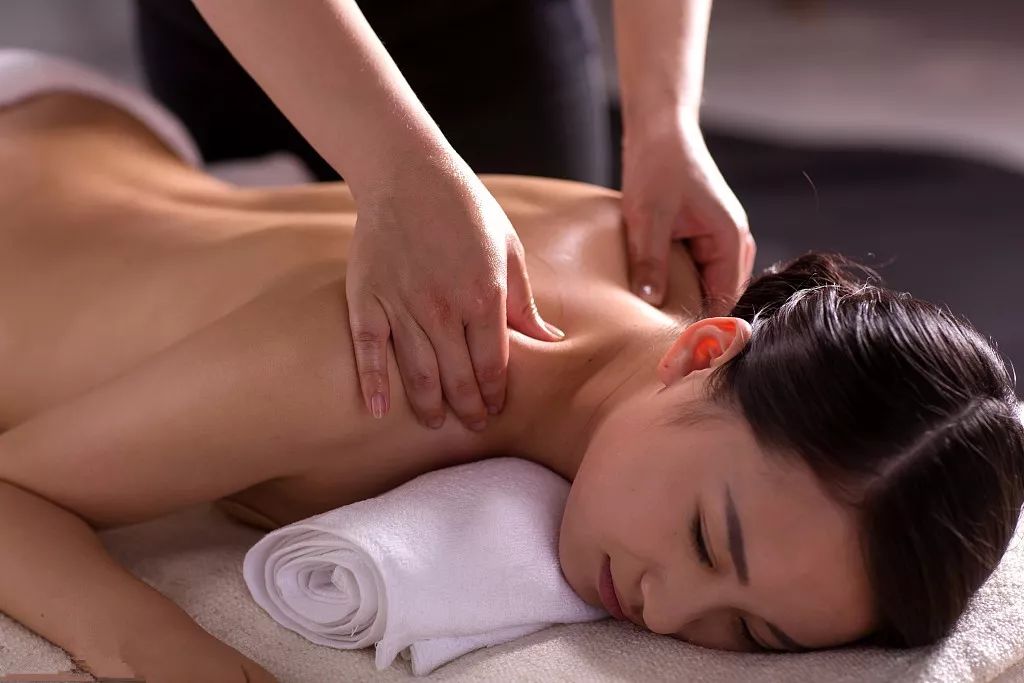
Generally speaking, massaging along the meridian is reinforcing, while massaging against the meridian is draining.
Light pressure during massage is reinforcing, while heavy pressure is draining.
Short duration of massage is reinforcing, while long duration is draining.
Small area of massage is reinforcing, while large area is draining.
4. Do I need to memorize all the more than three hundred acupuncture points?
In TCM, there is a saying during meridian massage called “pain indicates the point”; that is, the painful area is the acupuncture point for massage. For example, if you know you have a heart condition, you can slowly press along the corresponding Heart Meridian and Pericardium Meridian, feeling the sensations along the entire meridian. If some areas feel sore, some feel sharp pain, some feel numbness, and some feel sour or swollen, then you should focus your massage on the most painful area, kneading and dispersing the disease, and even cupping, moxibustion, or tapping can be applied. The more pronounced the pain, the more you should persist in stimulating that area, and your body’s condition will improve quickly.
Some people know they have heart disease, but when pressing on these two meridians, they do not feel significant pain. In this case, you should check both arms because the meridians in the body are symmetrical and consistent, but when there is illness, the responses of the left and right meridians may not be the same. The area with significant pain indicates which side the disease is leaning towards, which also shows that the Qi and blood in that meridian are insufficient and the response is slow. In this case, treatment should focus on dietary therapy first to replenish Qi and blood, while slowly feeling along that meridian to see if there are any hard lumps, if there is excess flesh, or if it is slightly raised compared to other areas, then focus on kneading that area. If you only memorize all the acupuncture points but ignore the most painful point, the treatment effect will not be good.
Let’s start with the most commonly used Zu Taiyang Pang Guang Jing (Foot Taiyang Bladder Meridian), as this meridian has the most Yang Qi and the widest treatment range, making it the most commonly used meridian. The starting point of the Bladder Meridian is at the Jingming point at the corner of the eye, ascending over the forehead to the top of the head, running down the back of the neck, the back, the outer side of the thigh, the back of the calf to the Zhi Yin point on the outer side of the little toe. It has a total of 67 acupuncture points, making it the longest and most acupuncture points of all meridians in the body.
When the Bladder Meridian reaches the Zhi Yin point at the foot, its flow does not stop but continues through the little toe, ascending from the Yong Quan point at the center of the foot. At this point, the meridian has a new name – Zu Shaoyin Shen Jing (Foot Shaoyin Kidney Meridian).
The Kidney Meridian starts below the little toe, slanting towards the center of the foot, ascending along the inner edge of the foot and lower limb, passing through the abdomen to the chest, connecting with the next meridian, Shou Jueyin Xinbao Jing (Hand Jueyin Pericardium Meridian).
From the Bladder Meridian to the Kidney Meridian, we can see:
1. The meridians are flowing and have a directional flow; the Bladder Meridian flows from top to bottom, while the Kidney Meridian flows from bottom to top.
2. The Bladder Meridian and the Kidney Meridian are actually one connected meridian, only separated at the Zhi Yin point on the outer side of the little toe. The Bladder Meridian runs on the outer side of the body, while the Kidney Meridian runs on the inner side. Because this Yang and Yin meridian is actually a connected meridian, stimulating the Bladder Meridian will also affect the Kidney Meridian; stimulating the Kidney Meridian will also affect the Bladder Meridian, which TCM refers to as “mutually exterior and interior”. The organs connected by these two meridians – the Kidney and Bladder – also mutually exterior and interior.
3. The Bladder Meridian is the meridian with the most Yang Qi among the Yang meridians, while the Kidney Meridian is the meridian with the heaviest Yin Qi among the Yin meridians, which perfectly aligns with the characteristics of Yin and Yang balance in TCM.
4. The Bladder Meridian leads, and the Kidney Meridian follows; the Bladder Meridian is the source of the Kidney Meridian. Therefore, performing techniques such as pushing, massaging, or acupuncture on the Bladder Meridian can promote the downward flow of the Bladder Meridian, which in turn stimulates the Kidney Meridian and nourishes the kidneys.
When performing techniques on the Kidney Meridian, if the Kidney Meridian runs faster but the Bladder Meridian cannot keep up, there will be gaps and interruptions. This is why patients often experience Qi deficiency when only massaging the Kidney Meridian.
Connected to the Bladder Meridian is the Shou Taiyang Xiao Chang Jing (Hand Taiyang Small Intestine Meridian). It starts at the outer side of the little finger at the Shao Ze point, ascending along the outer edge of the upper limb, passing over the shoulder and dividing into two branches: one goes from the neck to the cheek, to the ear, to the eye at the Jingming point, connecting with the Bladder Meridian, while the other enters the clavicle, into the thoracic cavity, and finally reaches the heart.
This meridian runs on the outer side of the arm, belongs to the Yang meridians, and is connected to the Bladder Meridian, forming a long and complete Taiyang meridian. The Small Intestine Meridian is in front, and the Bladder Meridian is behind. The Small Intestine Meridian is the source of the Bladder Meridian; when the Bladder Meridian is uncomfortable, there may also be cervical spondylosis, low back pain, or leg pain. In addition to massaging the Bladder Meridian, massaging the Small Intestine Meridian is also effective and even more effective.
The Small Intestine Meridian is also connected to the Shou Shaoyin Xin Jing (Hand Shaoyin Heart Meridian). The Heart Meridian starts at the heart and has several branches: one branch goes down to the Small Intestine, one goes up along the esophagus to the eyes, and another goes up in the lungs, exiting under the armpit, running along the back edge of the upper arm to the inner wrist, reaching the Shao Chong point on the inner side of the little finger, then following to the outer side of the little finger at the Shao Ze point, and continues upward.
This is a meridian that transforms from Yin to Yang, a long meridian that is mutually exterior and interior, with Yin in front and Yang behind. Therefore, massaging the Heart Meridian can not only treat discomfort related to the Heart Meridian, such as the heart, small intestine, lungs, esophagus, and eyes, but also promote and nourish the Small Intestine Meridian. Massaging it can treat diseases of the cervical spine, lumbar spine, and legs, as well as kidney diseases.
Whenever there are issues with the neck, shoulders, or back, you can feel for significant pain points along the outer side of the arm at the Small Intestine Meridian, and you will also feel blockages and pain along the corresponding Heart Meridian. Therefore, you should start by unblocking the Heart Meridian on the inner side of the arm, gently rubbing from the armpit down to the little finger, and then rubbing upward along the outer side of the little finger to the outer side of the arm, focusing on areas with pain. This way, you can treat all the organ issues connected to the Heart Meridian, Small Intestine Meridian, Bladder Meridian, and Kidney Meridian.
These four meridians form two long meridian groups that are mutually connected. They start from the heart, circulate around the limbs, and then push the Kidney Meridian towards the abdomen and chest.
Which meridian connects with the Heart Meridian in the chest?
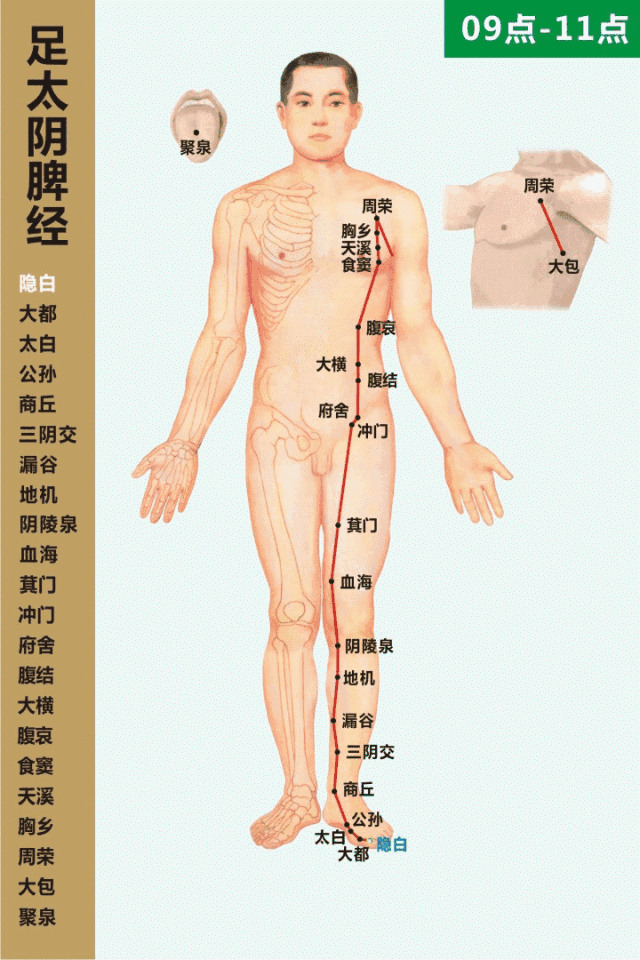
This is the Zu Taiyin Pi Jing (Foot Taiyin Spleen Meridian). At this point, some may ask, one is Shaoyin, and the other is Taiyin; it seems that balance in Yin and Yang cannot be achieved. Why is that? We will discuss this shortly.
After the Kidney Meridian connected to the Bladder Meridian reaches the chest, it connects with the Shou Jueyin Xinbao Jing (Hand Jueyin Pericardium Meridian), which is a connection between Yin meridians. However, one is called Shaoyin, and the other is called Jueyin, with different names and different degrees of Yin Qi. When the meridian reaches this point, it seems that the function and relationship are different from when it circulated around the limbs. Why? Because when the meridian reaches the Kidney Meridian, it is already very weak, so generally, we do not massage the Kidney Meridian; excessive massage will drain Qi. At this point, the meridians entering the abdomen and chest need to rest and replenish energy before continuing to circulate through the limbs, so the most potent Qi replenishing point, the Dan Tian point, is in the abdomen, and the meridians returning through the abdomen are the already fatigued Kidney Meridian, Liver Meridian, and Spleen Meridian.
There is also a meridian that passes through the abdomen – the Zu Yangming Wei Jing (Foot Yangming Stomach Meridian), which also passes through the abdomen, but its direction of flow is different from that of the Kidney Meridian, Liver Meridian, and Spleen Meridian, as it runs from the head through the chest and abdomen to the feet. The Stomach Meridian also needs to replenish energy here to enhance its downward force and strengthen the digestive capacity of the Spleen and Stomach.
The next round of circulation through the limbs starts from the Kidney Meridian, passing to the Pericardium Meridian, which runs along the inner side of the limbs. Therefore, it connects with the Shou Shaoyang San Jiao Jing (Hand Shaoyang San Jiao Meridian), which runs along the outer side of the arms, and the Zu Shaoyang Dan Jing (Foot Shaoyang Gallbladder Meridian), which runs along the outer side of the legs, and then connects with the Zu Jueyin Gan Jing (Foot Jueyin Liver Meridian), which runs along the inner side of the legs. This forms another completely connected and mutually exterior and interior meridian group, ultimately pushing the Liver Meridian towards the lower abdomen and chest to rest, replenish energy, and continue forward along a different route.
The last round of circulation involves the four meridians: the Liver Meridian in the chest, which transmits to the Shou Taiyin Fei Jing (Hand Taiyin Lung Meridian). The specific order of circulation is as follows: Lung Meridian → Large Intestine Meridian → Stomach Meridian → Spleen Meridian.
All diseases can be found along the meridians
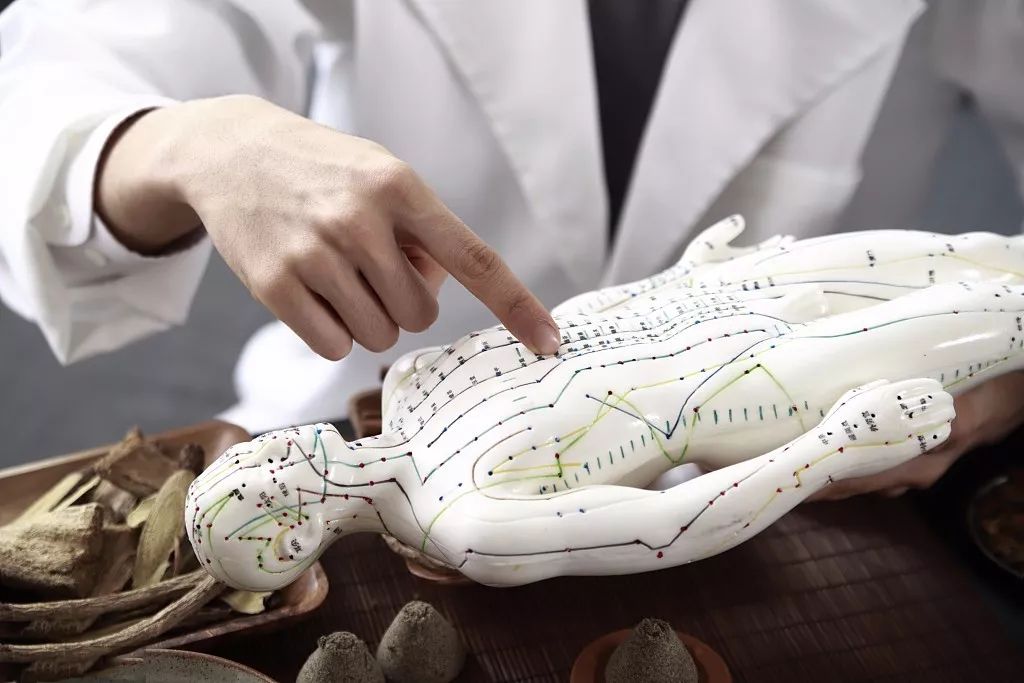
From the above discussion, everyone will understand that these 12 meridians are divided into 3 major meridian groups. These 3 major meridian groups circulate around the limbs in a large circle and then return to the abdomen and chest, making it easier to remember. You only need to memorize the 4 meridians in each group and remember the names of the organs connected to these 4 meridians. If any one of these 4 organs becomes ill, you can start looking for pain points from the source of these 4 meridians, which is the meridian running along the inner side of the arm from the chest to the hand, and slowly knead, tap, or scrape to gradually smooth it out. This way, not only will the treatment be effective, but it will also prevent future complications and recurrence.
The circulation of the 3 major meridian groups in the body is already clear, but which of these 3 major meridian groups comes first and which comes last?
TCM divides them as follows:
Group 1: Running on the outer side, is Lung Meridian → Large Intestine Meridian → Stomach Meridian → Spleen Meridian
Group 2: Running on the inner side, is Heart Meridian → Small Intestine Meridian → Bladder Meridian → Kidney Meridian
Group 3: Running in the middle, is Pericardium Meridian → San Jiao Meridian → Gallbladder Meridian → Liver Meridian
Additionally, when using meridians to treat diseases, it is essential to choose the right time. TCM believes that humans and the universe are closely related as a unified whole, and the human body is actually a microcosm of the universe. All changes in nature (such as the alternation of day and night) are closely related to human life activities. In ancient China, people divided the 24 hours of a day into 12 time periods, and TCM corresponds each time period to the 12 meridians, as shown in the table below.
Group 1:
| Time Period | Time | Meridian |
| Yin Time | 3:00–5:00 | Lung Meridian |
| Chen Time | 5:00–7:00 | Large Intestine Meridian |
| Shen Time | 7:00–9:00 | Stomach Meridian |
| Si Time | 9:00–11:00 | Spleen Meridian |
Group 2:
| Time Period | Time | Meridian |
| Wu Time | 11:00–13:00 | Heart Meridian |
| Wei Time | 13:00–15:00 | Small Intestine Meridian |
| Shen Time | 15:00–17:00 | Bladder Meridian |
| You Time | 17:00–19:00 | Kidney Meridian |
Group 3:
| Time Period | Time | Meridian |
| Xiu Time | 19:00–21:00 | Pericardium Meridian |
| Hai Time | 21:00–23:00 | San Jiao Meridian |
| Zi Time | 23:00–1:00 | Gallbladder Meridian |
| Chou Time | 1:00–3:00 | Liver Meridian |
What is the significance of the correspondence between the 12 time periods and the 12 meridians?
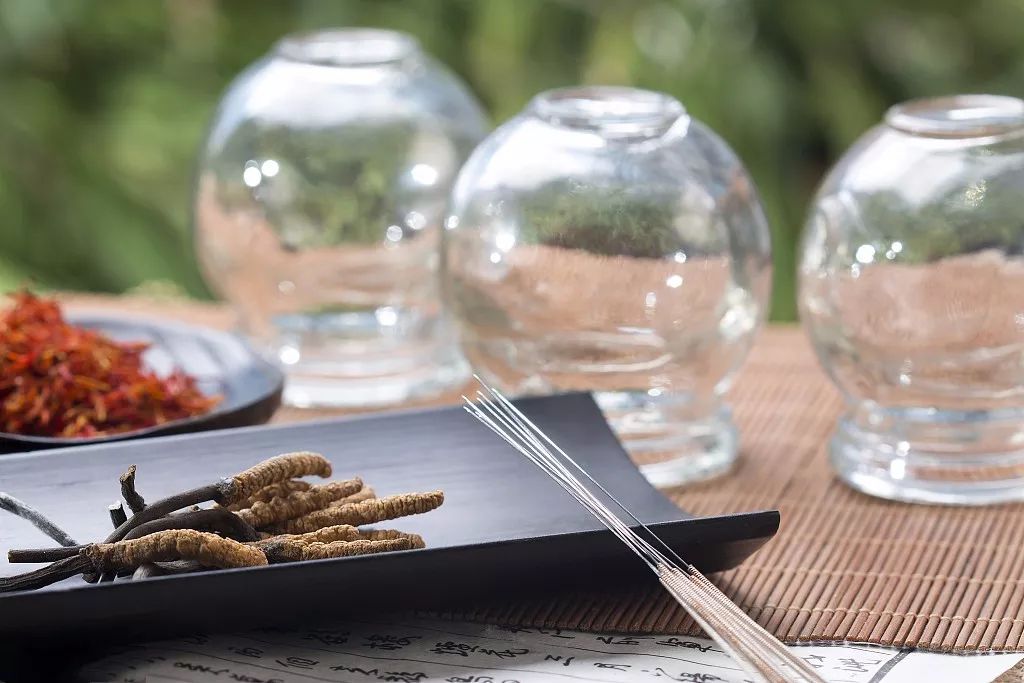
“Qi and blood arrive at the right time to be abundant; Qi and blood leave when overdue to be deficient. Drain when it is abundant, and supplement as it departs; when timely, it rises; when overdue, it closes.” The 12 meridians flow in a time sequence, just like tides; wherever they flow, that meridian experiences a “high tide,” and at that time, the Qi and blood in that meridian are most abundant. Therefore, many practitioners prefer to unblock the meridian with the most abundant Qi and blood at specific times or take herbs to regulate the corresponding organ at that time, achieving twice the result with half the effort. This is the relationship between meridians, organs, and time.
We have divided these 12 meridians into 3 major groups, making it simple to use time to prevent and treat diseases.
If there are discomforts in the Lung Meridian, Large Intestine Meridian, Stomach Meridian, or Spleen Meridian, it is best to massage and treat them in the morning or forenoon.
If there are discomforts in the Heart Meridian, Small Intestine Meridian, Bladder Meridian, or Kidney Meridian, it is best to massage and treat them at noon or in the afternoon.
If there are discomforts in the Pericardium Meridian, San Jiao Meridian, Gallbladder Meridian, or Liver Meridian, it is best to massage and treat them in the evening.
For example, for someone with a stomach issue, they can find pain points on the Lung Meridian and Large Intestine Meridian on the outer side of the arm in the morning or forenoon, and then find pain points on the Stomach Meridian and Spleen Meridian on the legs, kneading them in order.
For those with neck and shoulder pain or back issues, they can find pain points on the Heart Meridian and Small Intestine Meridian on the inner side of the arm at noon or in the afternoon, kneading them slowly, and then proceed to massage the painful neck and back areas.
For those with liver issues, it is best to find pain points on the Pericardium Meridian and San Jiao Meridian in the middle of the arm in the evening, kneading and unblocking them, and then find painful or blocked areas on the Gallbladder Meridian on the outer side of the legs and the Liver Meridian on the inner side of the legs for massage.
For those with good health and sufficient Qi and blood, they can use slightly heavier techniques when unblocking the meridians, applying tapping or scraping methods on painful or blocked areas. For those who are weak and deficient in Qi and blood, they should not rush; the pressure during massage should be lighter, and the selected acupuncture points and pain points should be fewer. It is best to choose the first two meridians in each group (the arm meridians) for massage, while minimizing contact with the last meridians (Kidney Meridian, Liver Meridian, Spleen Meridian).
Understanding these principles allows you to unblock the meridians based on your physical condition, different seasons, and time, while supplementing Qi and blood and expelling cold and dampness. If used properly, everyone can skillfully utilize the miraculous meridians to safeguard their health and that of their loved ones.
Finally, I would like to add that the “Dan Tian” mentioned earlier is like a nuclear reactor within the body, possessing immense energy. Various martial arts in our country have mentioned “Dan Tian” since ancient times. When cultivated to a certain level, a warm airflow will form in the Dan Tian area, gathering into a tangible form and dispersing into an intangible form, running along the Ren and Du meridians, which are aligned along the centerline of the body. The front is the Ren Meridian, and the back is the Du Meridian.
When the Qi flows around the Ren and Du meridians, it is called “Small Zhou Tian”. The Small Zhou Tian runs along the front of the body through the Ren Meridian, which has a comprehensive effect on all Yin meridians. The Dan Tian that the Ren Meridian passes through is the place where men store essence and women maintain the womb, also known as the “source of life”; while the “Du” in the Du Meridian, which runs along the centerline of the back, has a “supervisory” function, and since the Du Meridian runs through the spinal cord, it is directly connected to the spinal cord and brain, thus having a significant relationship with a person’s spirit, will, and thinking. The Ren and Du meridians are also connected to all organs in the body. When the true Qi is sufficient, all the five organs and six bowels can be directly nourished.
The functions of the Ren and Du meridians are what TCM refers to as the functions of the “Kidney”. TCM believes that the Kidney is the “foundation of pre-natal essence” and also believes that the formation of the fetus begins in the Kidney, hence the saying, “Before this body exists, there are two kidneys; therefore, the Kidney is the root of the organs and the root of the twelve meridians.” The functions of the Kidney include: storing essence, governing reproduction, governing the fire of the life gate, warming and illuminating the whole body, governing bones, governing marrow, governing blood production, governing water, and governing the intake of Qi.
Throughout history, many methods of internal cultivation have been able to generate and nourish Qi, which is essentially about unblocking the Small Zhou Tian and the major Zhou Tian centered around the 12 meridians. Therefore, some high monks meditate in silence, abstaining from food and drink, using the internal cultivation they have developed to nourish their bodies, promote the flow of meridians, and ensure the longevity of life. Tai Chi, Baguazhang, and Wuqinxi are also practices that use gentle Qigong movements to unblock the meridians.
If you can cultivate internal energy or persist in meditating every night, allowing the Qi in your Dan Tian to fill and promote the flow of all meridians, that would be ideal, but it is difficult for ordinary people to achieve. However, we can replenish Qi and blood through dietary therapy to supplement Kidney Qi, and over time, we can achieve the same effect.
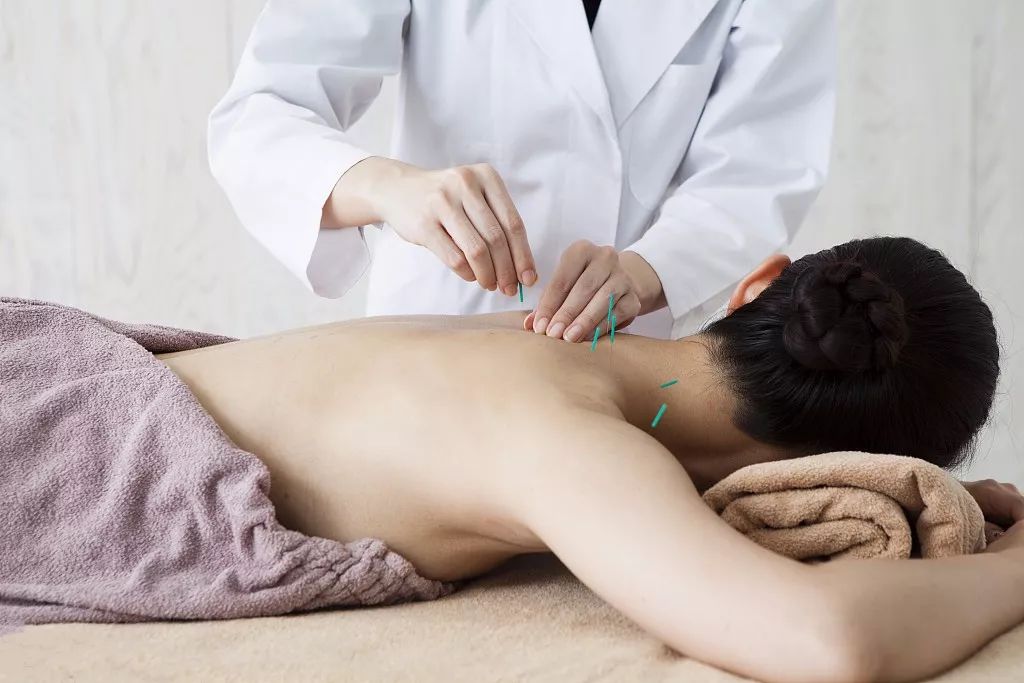
Touch Diagnosis of Meridians
The sensation of the fingertip can detect abnormal responses of the meridians and acupuncture points. This method is simple, easy to perform, and accurate (it is one of the essential diagnostic methods in acupuncture clinical practice).
Method: Touch along the meridian; if there is heat, swelling, strong elasticity, significant tenderness, or subcutaneous nodules, it can be identified as excess meridian Qi; if the surface temperature is low, lacking elasticity, and pressing causes soreness, numbness, or sinking, it can be identified as deficient meridian Qi.
During touch, if there are hard nodules, tenderness, sensitivity, or quick sensations, this point is a disease point. Strong tenderness often indicates an excess condition; quick sensations often indicate a deficiency condition. Disease points help clarify the diagnosis, and needling or moxibustion at these points often yields good results.
The order of touch diagnosis: back Shu points, Mu points, local points, Yuan points, Luo points, special examination points, sensitive points, and sensitive areas, etc. Any suspicious meridian should be examined in detail.
Twelve Meridian Disease Touch Diagnosis Key Points
Lung Meridian: Lung Shu, Zhong Fu, Kong Zui, Gao Huang, Chi Ze.
When the Lung Meridian has excess heat, there is tenderness 0.5 inches beside the thoracic vertebrae 1-3, and tenderness is also present at the Shanzhong and Daju points. When the Lung Meridian Qi is obstructed, there is tenderness at the Dan Zhong point. When the Lung Meridian is deficient and cold, there is a feeling of heaviness at the Feng Men and Da Zhu points. For hemoptysis or blood in the stool, there is tenderness at the Kong Zui point, or pressing causes a feeling of heaviness. When the meridian Qi is deficient, the Gao Huang point appears swollen or elastic, and the skin temperature is low.
Large Intestine Meridian: Large Intestine Shu, Tian Shou, Wen Liu, Qu Chi, He Gu.
When the meridian Qi is in excess heat or there are excretion obstacles, there is tenderness at the Qu Chi, Lung Shu, Tian Shu, and Qi Zhu points. When the meridian Qi is stagnant, there is tenderness at the Da Ju point. In cases of enteritis, there is significant tenderness at the Shou San Li, Shang Ju Xu, and Tian Shu points, and the skin temperature is higher than adjacent points. In chronic enteritis, the skin temperature is low, and there is a quick sensation upon touch.
Stomach Meridian: Stomach Shu, Zhong Yuan, Liang Qiu, Zu San Li, Feng Long.
When the Stomach Meridian has excess heat, there is tenderness at the Zhong Yuan and Liang Qiu points. When there is excessive stomach acid, there is tenderness at the Ju Que and Bu Rong points.
When the Stomach Meridian is deficient and cold, pressing the Zhong Wan and Zu San Li points feels comfortable. For stomach ulcers, there are sensitive points at the Stomach Shu and its outer side, and pressing the buttocks causes tenderness radiating down to the knee.
Severe stomach pain: there is significant tenderness at the Tian Zong point, and pressing it can relieve pain.
Spleen Meridian: Spleen Shu, Zhang Men, Di Ji, Da Bao, Spleen Shu.
When there is indigestion or dysfunction, there is tenderness at the Spleen Shu, Zhang Men, and Da Bao points. When blood circulation is unbalanced, the Spleen Shu point appears tense or tender. For Spleen heat or Qi stagnation, there is significant tenderness at the Di Ji point. When the Spleen is deficient and causes bloating, pressing the Spleen Shu point feels heavy or the skin temperature is low.
Heart Meridian: Heart Shu, Ju Que, Yin Xi, Shao Hai.
When the Heart Meridian has excess heat, there is tenderness on the inner side of the Heart Shu point. For heart valve diseases, the Ju Que point is swollen, and there are sensitive points from the Heart Shu to the Gao Huang point. When the meridian Qi is deficient or the function is low, there is tenderness at the San Yin Jiao, Shui Fen, and Kidney Shu points.
Small Intestine Meridian: Small Intestine Shu, Guan Yuan, Yang Lao, Xiao Hai, Xia Ju Xu.
For Small Intestine Meridian diseases, there are responses at the Guan Yuan and Yang Lao points. When invaded by wind and cold, there is tenderness at the Tian Zong, Feng Men, and Xiao Hai points. When Small Intestine Meridian diseases transfer to the Heart Meridian, pressing the Guan Yuan point is effective. For shoulder swelling and pain due to Small Intestine Meridian Qi obstruction, there is tenderness at the Xia Ju Xu point, and needling is effective. For low back pain at the Small Intestine Shu point, there is significant tenderness at the Yang Lao point, and needling is effective.
Bladder Meridian: Bladder Shu, Zhong Ji, Jin Men, Wei Zhong, Kun Lun, Tian Zhu, Ba Liao.
When the meridian Qi is in excess heat, the Wei Zhong point has high skin temperature, and the collaterals are full. When damp heat descends and the meridian Qi is obstructed, there is tenderness at the Zhong Ji, Jin Men, and Bladder Shu points. When invaded by wind and cold, there is tenderness at the Tian Zhu, Ba Liao, and Cheng Shan points. When the meridian Qi is deficient, pressing the Zhong Ji and Bladder Shu points feels quick.
Kidney Meridian: Kidney Shu, Jing Men, Shui Quan, Shui Fen, Huang Shu.
For Kidney Meridian diseases, there is tenderness at the Shui Quan, Shui Fen, and Huang Shu points. For kidney diseases, there is tenderness at the Kidney Shu and Jing Men points. When the kidney excretion function is impaired, the Zhi Bin point shows a positive response (hardness, tenderness). Therefore, moxibustion at the Zhi Bin point has a detoxifying effect. When there are urinary system issues, there is tenderness at the Ba Liao point.
Pericardium Meridian: Jue Yin Shu, Dan Zhong, Xie Men, Da Ling.
When emotions are unsettled, and laughter and tears are unpredictable, there is significant tenderness at the Dan Zhong and Xie Men points. For women with menstrual irregularities, dysmenorrhea, or lower abdominal blood stasis, there is tension or tenderness at the Xie Men point, and needling can regulate menstruation and relieve pain. For palpitations, pressing the Jue Yin Shu and Dan Zhong points can provide relief, and moxibustion is also effective.
San Jiao Meridian: San Jiao Shu, Shi Men, Wei Yang, Hui Zong.
When the meridian Qi is obstructed, there is tenderness at the Hui Zong, Wei Yang, and Shi Men points. When the meridian Qi is in excess heat, the San Jiao Shu area is tense, and there is strong tenderness at the Hui Zong point. For urinary retention, which belongs to the San Jiao Meridian Qi not being expressed, there is fullness at the Shi Men point.
Gallbladder Meridian: Gallbladder Shu, Ri Yue, Tian Zong, Jing, Yang Ling Quan, Wai Qiu.
For cholecystitis, there is tenderness at the Ri Yue, Jing Men, and Tian Zong points. When the Gallbladder Meridian has excess heat, the Wai Qiu point has high skin temperature. When the meridian Qi is deficient, pressing the Gallbladder Shu and Ri Yue points feels comfortable.
Liver Meridian: Liver Shu, Qi Men, Zhong Du, Qu Quan.
When the meridian Qi is stagnant (insomnia, irritability, hypertension), there is often swelling and tenderness at the Liver Shu point, and there is strong tenderness at the Zhong Du point. For hepatitis (excess heat in the meridian Qi), there may be a sensitive area from two inches above the inner ankle to the Zhong Du point, and the Yang Ling Quan and Wai Qiu points may also show tenderness. For sexual dysfunction, pressing the Qu Quan point may cause pain or heaviness.
By using the above methods to identify the disease meridian and disease points, combined with the four diagnostic methods and eight principles, you can determine the cause, location, and nature of the disease, and propose effective treatment plans.
You can remember the distribution pattern of the meridians without rote memorization:
Order of meridian flow:
Shou Taiyin Fei Jing (Hand Taiyin Lung Meridian) → Shou Yangming Da Chang Jing (Hand Yangming Large Intestine Meridian) → Zu Yangming Wei Jing (Foot Yangming Stomach Meridian) → Zu Taiyin Pi Jing (Foot Taiyin Spleen Meridian) (Hand Shaoyin Heart Meridian)
Shou Shaoyin Xin Jing (Hand Shaoyin Heart Meridian) → Shou Taiyang Xiao Chang Jing (Hand Taiyang Small Intestine Meridian) → Zu Taiyang Pang Guang Jing (Foot Taiyang Bladder Meridian) → Zu Shaoyin Shen Jing (Foot Shaoyin Kidney Meridian) (Hand Jueyin Pericardium Meridian)
Shou Jueyin Xinbao Jing (Hand Jueyin Pericardium Meridian) → Shou Shaoyang San Jiao Jing (Hand Shaoyang San Jiao Meridian) → Zu Shaoyang Dan Jing (Foot Shaoyang Gallbladder Meridian) → Zu Jueyin Gan Jing (Foot Jueyin Liver Meridian) (Hand Taiyin Lung Meridian)
Finally, remember:
Mnemonic: Lung, Large Intestine, Stomach, Spleen, Heart, Small Intestine, Bladder, Kidney, Pericardium, San Jiao, Gallbladder, Liver.
Correspondence:
Shou Taiyin (Lung) → Shou Yangming (Large Intestine) → Zu Yangming (Stomach) → Zu Taiyin (Spleen) → (Shou Shaoyin)
Shou Shaoyin (Heart) → Shou Taiyang (Small Intestine) → Zu Taiyang (Bladder) → Zu Shaoyin (Kidney) → (Shou Jueyin)
Shou Jueyin (Pericardium) → Shou Shaoyang (San Jiao) → Zu Shaoyang (Gallbladder) → Zu Jueyin (Liver) → (Shou Taiyin)
Acupuncture Point Memory Techniques
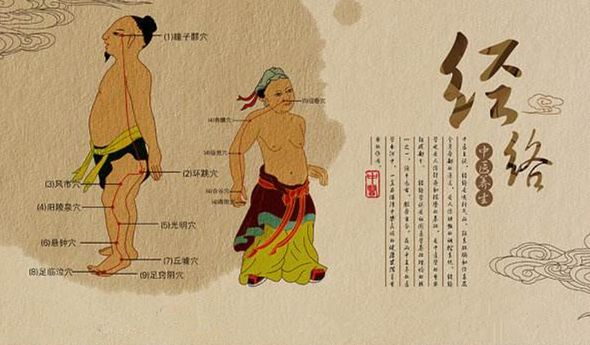
1. Fainting – Water Ditch, Zhong Chong, Yong Quan, Zu San Li.
Mnemonic: Fainting should be awakened in the water ditch by the spring in the mountains.
2. Collapse – Su Jiao, Water Ditch, Nei Guan.
Mnemonic: Collapse should quickly (Su) close the water ditch.
3. Convulsions – Bai Hui, Yin Tang, Ren Zhong, He Gu, Tai Chong.
Mnemonic: In the hall (Ren Zhong), the fragrance of Bai He causes convulsions.
4. Stroke Closed Syndrome – Twelve Well Points, Water Ditch, Tai Chong, Feng Long.
Mnemonic: Stroke is caused by the foul smell of the twelve water ditches, causing a loud (Feng) sound and falling.
5. Stroke Collapse Syndrome – Guan Yuan, Shen Que (Ginger Moxibustion). Sweating with Yin Xi, Fu Liu, and urinary incontinence with San Yin Jiao.
Mnemonic: Stroke collapse syndrome will cause the spirit to leave the body.
6. Dysmenorrhea – (Excess Syndrome) Zhong Ji, Ci Liao, Di Ji. (Deficiency Syndrome) Qi Hai, Guan Yuan, Zu San Li, San Yin Jiao.
Mnemonic: Excess pain is due to Zhong Ji (Zhong Ji) eating low-grade (Di Ji) food. Deficiency pain is due to the three Yin days being in the mountains for too long without closing the circle (Yuan).
7. Internal Organ Cramping Pain
(1) Heart Angina – Heart Shu, Jue Yin Shu, Nei Guan, Dan Zhong.
Mnemonic: Heart angina should rest in the inner hall; the calmer the heart, the better the feeling.
(2) Acute Cholecystitis, Gallstones – Gallbladder Shu, Liver Shu, Ri Yue, Qi Men, Yang Ling Quan, Gallbladder Point.
Mnemonic: Gallbladder diseases are treated with liver and gallbladder; Ri Yue is continuous, and Qi Men opens itself.
(3) Gallbladder Ascaris – Ying Xiang through Si Bai, Jiu Wei through Ri Yue, Gallbladder Point, Zhong Wan, Yang Ling Quan.
Mnemonic: The nine tails steal Ri Yue; do you want (Ying Xiang) to steal Si Bai? Passing by Yang Ling Quan, gallbladder fear early morning and evening.
(4) Kidney Colic – Kidney Shu, San Jiao Shu, Guan Yuan, Yin Ling Quan, San Yin Jiao.
Mnemonic: Kidney colic only needs to be at the Yang Ling Quan in the Grand View Garden; three calls and three responses will heal the kidney.
8. Toothache – He Gu, Xia Guan, Jia Che.
Mnemonic: Why (He Gu) go down? Toothache.
9. High Fever – Da Zhui, Twelve Well Points, Ten Xuan, Qu Chi, He Gu.
Mnemonic: Why does the high fever take twelve pounds of Da Zhui to the pool? It is to release the heat.
10. Vascular Headache
(1) External Headache – Bai Hui, Tai Yang, Feng Chi, He Gu.
Mnemonic: Why (He Gu) does the sun wind always visit (Bai Hui) me? Let me have a headache!
(2) Internal Injury Headache
A. Liver Yang Headache – Bai Hui, Feng Chi, Tai Chong, Tai Xi.
Mnemonic: Ci (Chi) Xi (Xi) visits Tai Zong (Tai Chong); great anger causes liver yang to rise.
B. Kidney Deficiency Headache – Bai Hui, Kidney Shu, Spleen Shu, Zu San Li.
Mnemonic: Walking three miles to visit a friend, the friend says: I have both spleen and kidney deficiency, causing headache.
C. Blood Deficiency Headache – Bai Hui, Heart Shu, Spleen Shu, Zu San Li.
Mnemonic: Walking three miles to visit a friend, the friend says: I have both heart and spleen deficiency, causing headache.
D. Phlegm Turbidity Headache – Tou Wei, Tai Yang, Feng Long, Yin Ling Quan.
Phlegm turbidity headache can cause swelling at the temples and Tai Yang, possibly due to excessive turbidity at Yin Ling Quan.
E. Blood Stasis Headache – A Shi point, He Gu, Xue Hai, San Yin Jiao.
Why does blood stasis cause headache? It is because three Yin Qi converge (i.e., San Yin Jiao) at the Blood Sea!
11. Acute Lumbar Strain – Kidney Shu, Yao Yan, Wei Zhong.
For lumbar strain, rub the kidney area and listen to a soothing tune.
12. Vomiting – Zhong Wan, Nei Guan, Zu San Li.
In the water ditch, walking three miles, Zhong Wan feels uncomfortable and vomits.

Follow Mai Mai Yang Sheng to inquire about the following diseases (Disease Search)
Pediatric fever, pediatric diarrhea, night crying, pediatric massage, pediatric knowledge, low back pain, male health, kidney-replenishing dietary therapy, strengthening waist exercises, lumbar disc herniation, back pain, leg pain, cervical spondylosis, liver disease, liver nurturing, hangover relief, stomach disease, constipation, lower abdominal protrusion, gynecology, menstrual care, breast hyperplasia, breast cancer, postpartum care, acne, white hair, hair loss, breast enhancement, beauty, skin diseases, gallstones, pharyngitis, gout, toothache, snoring, oral ulcers, rhinitis, eye diseases, hands and feet, colds, coughs, insomnia, hemorrhoids, cerebral hemorrhage, hypertension, diabetes, heart disease, cardiovascular diseases, cancer, food properties, blood replenishment, weakness, obesity, thin legs, thin waist, dampness, meridians, Chinese patent medicines, hiccups
Diagnosis: Differentiation, back diagnosis, face diagnosis, acne, menstruation, tongue diagnosis, blue veins, sweat diagnosis, eye diagnosis, nails, navel (finding the cause)
Treating Hundreds of Diseases: Sitting, stretching, rolling back, scraping, tapping, cupping, tapping the gallbladder meridian, kneading the earth meridian, vinegar-soaked eggs, moxibustion on the abdomen, ginger, acupoint pressing, folk prescriptions, moxibustion, high leg raises

